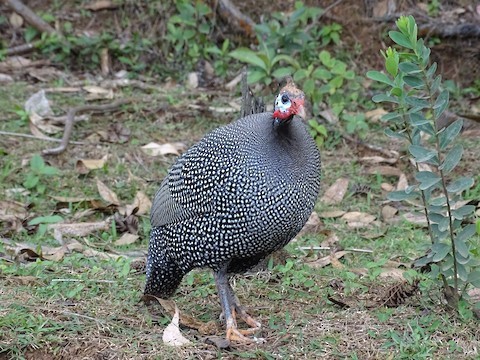Birdfinding.info ⇒ A widely introduced form of Helmeted Guineafowl that is uncommon across most of its natural range, although some feral or introduced populations are more observable. In Senegal, it can be found near Dakar at Popenguine and Bandia Reserves, and in the east in Niokolo-Koba National Park. In Ghana, it can be found near Accra at Shai Hills Resource Reserve, and in the north at Mole National Park. In Cape Verde, it seems to be most common on Santiago. In the Dominican Republic, it can often be found along the Rabo de Gato Trail.
“West African Guineafowl”
Numida meleagris galeatus
Tropical western Africa: savannas, brushlands, and various open and semiopen habitats of the Sahel and southwest. Apparently extirpated from large portions of its natural range, but possibly reintroduced to some of these areas and introduced elsewhere.
In the Sahel region from Senegal locally east to southwestern Chad and central Cameroon—but mostly absent from the Guinea highlands, Liberia, and Nigeria.
In southwestern Africa from the southern Republic of the Congo and D.R. Congo south to Namibia (e.g., Caprivi and Hardap).
Introductions. Centuries of domestication have led to feral populations in many parts of the world, although many remain semi-domestic, and have not become self-sustaining. The most southerly populations in Angola and Namibia may have resulted from introductions, as isolated groups in eastern Africa clearly must have.
Introduced populations have been established for centuries on several of the Cape Verde Islands: Raso, São Nicolau, Boa Vista, Maio, Santiago, and Fogo. However, it has disappeared from other islands in the archipelago (Bravo, Santo Antão, and São Vicente) and from Tenerife in the Canary Islands.

“West African Guineafowl,” N. m. galeatus. (São Vicente, Boa Vista, Cape Verde; November 7, 2014.) © Georges Olioso
Starting in the 1500s, the slave trade from West Africa to the New World brought large numbers to the Caribbean. Local populations persist on Cuba, Hispaniola, Puerto Rico, Culebra, St. John, St. Croix, St. Martin, and Barbuda. (The Barbuda population reportedly pertains to N. m. sabyi, the “Moroccan Guineafowl”, which is otherwise thought to be extinct.)
In the U.S., it appears to be expanding across much of Florida—from the western Panhandle east to Jacksonville and south along the western coast to Venice, in the interior to Lake Okeechobee, and along the eastern coast to Dade County. More tenuously established in east-central Texas College Station and Burleson County, and possibly also Aransas County.
Scattered populations across the Indian and Pacific Oceans appear well-established on Mauritius, northern Madagascar, and New Zealand (North and South Islands).
Identification
The archetypal guineafowl: deep-bodied with a long, thin neck and small, mostly unfeathered head. The body and wings are blackish and densely covered with white spots throughout.
“West African” can be distinguished from other forms of Helmeted Guineafowl by the color and shape of its bare parts: pale-blue-to-whitish facial skin; plump red wattles on the cheeks; and a small brownish horn or casque on the crown.
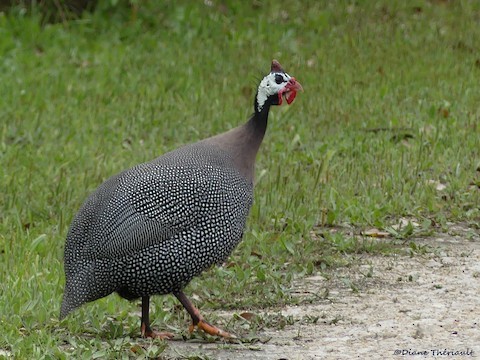
“West African Guineafowl,” N. m. galeatus, showing distinctive whitish facial skin, plump, red wattles, and small casque. (Goose Island State Park, Texas; April 1, 2019.) © Diane Thériault
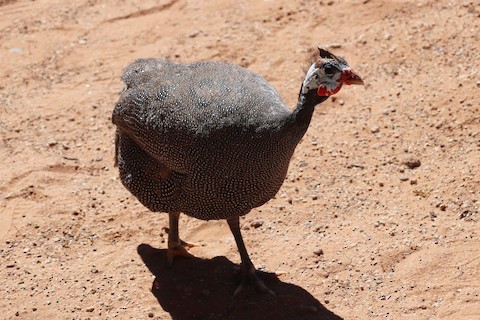
“West African Guineafowl,” N. m. galeatus, showing distinctive whitish facial skin, plump, red wattles, and small casque. (Sossusvley, Hardap, Namibia; April 23, 2018.) © Lorix Bertling
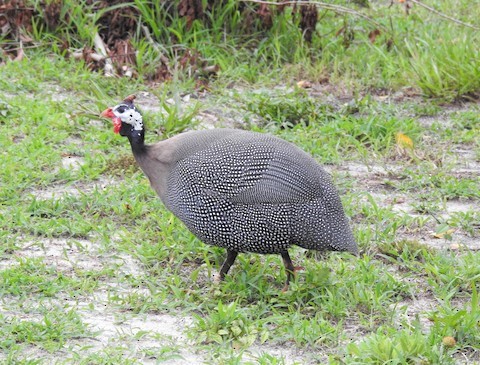
“West African Guineafowl,” N. m. galeatus, showing distinctive whitish facial skin, plump, red wattles, and small casque. (Laurel, Florida; June 30, 2018.) © Valentina Roumi
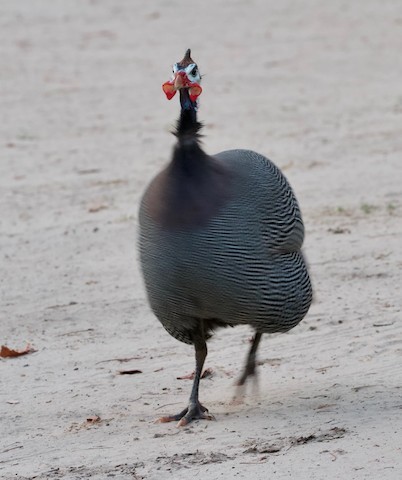
“West African Guineafowl,” N. m. galeatus, providing a profile view of its distinctive, broad red wattles. (Caprivi Mutoyo Lodge, Caprivi, Namibia; October 26, 2019.) © Bert Fisher

“West African Guineafowl,” N. m. galeatus. (Mole National Park, Ghana; April 1, 2019.) © graichen & recer
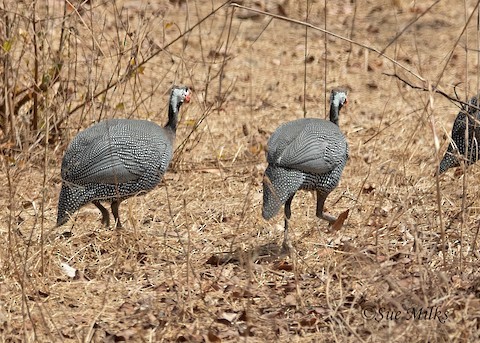
“West African Guineafowl,” N. m. galeatus. (Mole National Park, Ghana; March 8, 2019.) © Sue Milks

“West African Guineafowl,” N. m. galeatus, in flight. (Sendero de las Aves, Camagüey, Cuba; February 28, 2018.) © Chirstoph Moning
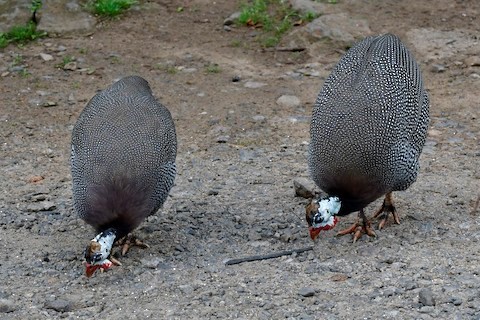
“West African Guineafowl,” N. m. galeatus. (Andasibe-Mantadia National Park, Madagascar; November 18, 2019.) © Gerd Schön
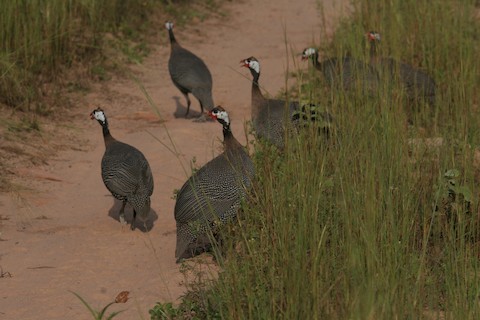
“West African Guineafowl,” N. m. galeatus. (Yankari Game Reserve, Bauchi, Nigeria; October 5, 2007.) © Fabio Olmos
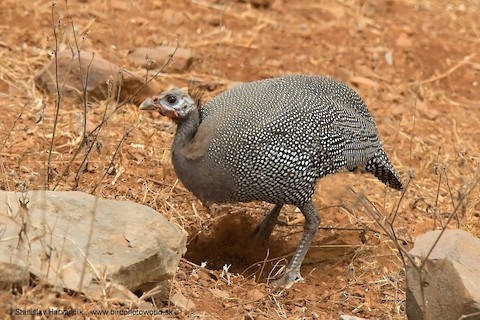
“West African Guineafowl,” N. m. galeatus, immature molting into adult plumage. (Tarrafal, Santiago, Cape Verde; February 24, 2020.) © Stanislav Harvančík

“West African Guineafowl,” N. m. galeatus, immature. (Serra Malagueta Natural Park, Santiago, Cape Verde; February 18, 2020.) © Stanislav Harvančík
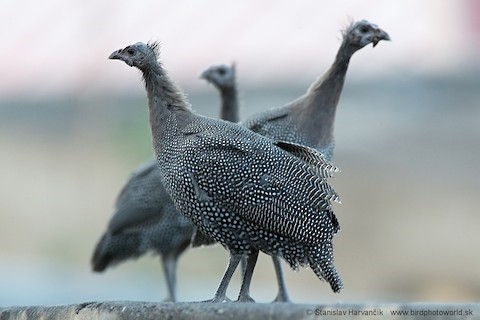
“West African Guineafowl,” N. m. galeatus, immatures. (Serra Malagueta Natural Park, Santiago, Cape Verde; February 18, 2020.) © Stanislav Harvančík
Cf. Other Helmeted Guineafowl. The forms of Helmeted Guineafowl are usually distinguishable based on the color and shape of the bare parts—although there is some internal variation within each form, as well as hybridization and some degree of apparent intergradation.
“Moroccan” has a small brown casque with elongated, upward-pointing feathers on the back of the head, whitish facial skinwhitish facial skin, and a “handlebar moustache” that consists of a long, broad, curled red wattle on each cheek, and a fleshy red connection across the cere.
“West African” has a small brown casque, whitish facial skin, and a “handlebar moustache” that consists of a long, broad, curled red wattle on each cheek, and a fleshy red connection across the cere.
“Ethiopian” has a small-to-medium-sized brown casque, bluish facial skin, and a cluster of bristles on the cere.
“Reichenow’s” has a very tall orange-brown casque, turquoise facial and neck skin, a black dewlap, and a “handlebar moustache” that consists of a long, broad, curled red wattle on each cheek, and a fleshy red connection across the cere.
“Tufted” has a tall orange-brown casque with a red base, red cere, turquoise facial and neck skin, a dark-blue or violet dewlap, and long, thin, pointed cheek-wattles that are bluish with red tips.
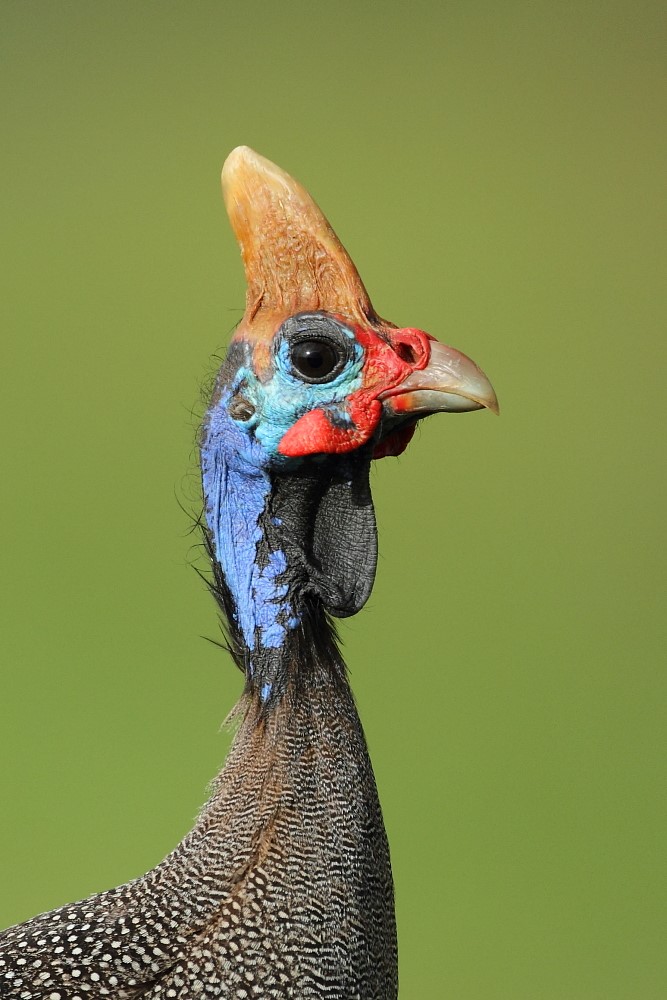
“Reichenow’s Guineafowl,” N. m. reichenowi, the champion of helmets, showing its distinctively tall orange-brown casque, red caruncles, turquoise cheeks, purplish neck-skin, and black dewlap. (Tarangire National Park, Tanzania; February 2, 2013.) © Darran Rickards

“West African Guineafowl,” N. m. galeatus, showing distinctive white facial skin, small casque, and red “handlebar moustache.” (Goose Island State Park, Texas; April 1, 2019.) © Diane Thériault
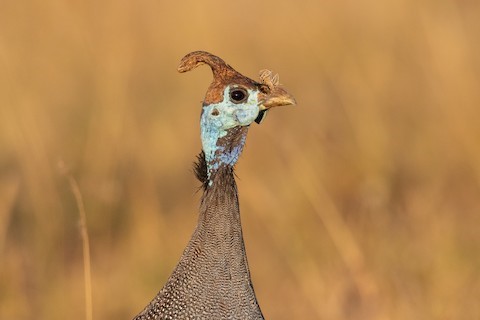
“Ethiopian Guineafowl,” N. m. meleagris, showing its small brown casque, bluish facial skin, and cluster of bristles on the cere. (Yabello, Oromia, Ethiopia; December 30, 2019.) © Stefan Hirsch

“Tufted Guineafowl,” N. m. mitratus, showing its orange-brown casque with a red base, red cere, turquoise facial and neck skin, a dark-blue dewlap, and long, thin cheek-wattles that are bluish with red tips. (Kruger National Park, South Africa; April 18, 2019.) © Guenther Karmann
Notes
Monotypic form. One of five potentially distinct forms of Helmeted Guineafowl (Numida meleagris). See Frontiers of Taxonomy: The Many-Helmeted Guineafowl, an Awkward Foursome.
References
BirdLife International. 2018. Numida meleagris. The IUCN Red List of Threatened Species 2018: e.T22679555A132052202. https://dx.doi.org/10.2305/IUCN.UK.2018-2.RLTS.T22679555A132052202.en. (Accessed April 11, 2020.)
eBird. 2020. eBird: An online database of bird distribution and abundance. Cornell Lab of Ornithology, Ithaca, N.Y. http://www.ebird.org. (Accessed April 14, 2020.)
Garcia-del-Rey, E. 2011. Field Guide to the Birds of Macaronesia: Azores, Madeira, Canary Islands, Cape Verde. Lynx Editions, Barcelona.
Kirwan, G.M., A. Levesque, M. Oberle, and C.J. Sharpe. 2019. Birds of the West Indies. Lynx Edicions, Barcelona.
Madge, S., and P.J.K. McGowan. 2002. Pheasants, Partridges, and Grouse: A Guide to the Pheasants, Partridges, Quails, Grouse, Guineafowl, Buttonquails, and Sandgrouse of the World. Princeton University Press, Princeton, N.J.
Martínez, I., and G.M. Kirwan. 2020. Helmeted Guineafowl (Numida meleagris). In Handbook of the Birds of the World Alive (J. del Hoyo, A. Elliott, J. Sargatal, D.A. Christie, and E. de Juana, eds.). Lynx Edicions, Barcelona. https://www.hbw.com/node/53526. (Accessed April 11, 2020.)
Raffaele, H., J. Wiley, O. Garrido, A. Keith, and J. Raffaele. 1998. A Guide to the Birds of the West Indies. Princeton University Press, Princeton, N.J.
van Perlo, B. 2002. Birds of Western and Central Africa. Princeton University Press, Princeton, N.J.
Xeno-Canto. 2020. Helmeted Guineafowl – Numida meleagris. https://www.xeno-canto.org/species/Numida-meleagris. (Accessed April 14, 2020.)
